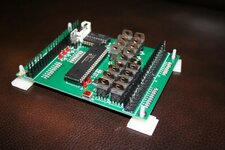
So I got my LED OCD board from Comet pinball on Monday. Took about 10 days to arrive from when I ordered it, of course I got hit with a Royal Mail handling fee and small import charge too.
Put it in my Lord of the Rings and once I managed to fix the issue I was having with the lamp matrix was able to have a proper look at what the OCE board is actually doing.
Installing was a breeze, it’s held onto the back box via 4 sticky holders, 1 at each corner of the board and seems firm enough. It also came with some screws and screw posts for mounting into a SAM back box. All you do is remove J12 & 13 off the driver board and connect to J3 & 4 on the OCD board. Then link the provided cables from J1 and 2 on the OCD board back onto J12 and 13 on the driver board.
The LED’s I’m using are the premium 2SMD LED’s from pinball-led.co.uk for the vast majority of inserts and also the green PoTD and red mode indicator lamps. Am using some basic 1 bulb LED’s in the 3 film title inserts and a colour changer behind the palantir globe. All of the GI are incandescent bulbs. We all know that most non-ghosting LED’s in Stern machines will still ghost slightly and whilst the OCD board isn’t connected there is the expected level of ghosting, not glaring by any means but noticeable if you look for it. Also the LED’s have the usual sharp on/off contrast too.
With the board connected, all of these issues are completely gone. There is absolutely zero ghosting and there is also a far more gradual brightness level increase and decrease, just like how incandescent bulbs work. For further proof, look at the videos without it and with it:
Just to give an overview on my LOTR lighting, all inserts have LED's, all of which are from the Premium 2SMD LOTR kit from pinball-led.co.uk. The film title inserts (blue) are regular single lamp LED's. All of the GI lamps are coloured incandescent bulbs, mix of green, red, yellow and blue. The white inserts are not as glaring in person as they look on the videos, I'm not exactly using a top end camera here
There is also a good length USB cable provided in the box which is long enough to reach from the board to the coin door via the cabinet. This allows you to connect a PC to the board and using the software, you can adjust the light levels of all lamps in the lamp matrix. The software is a bit basic in terms of the interface but does the job that it needs to. Have not tinkered with the different levels yet as the default settings already look great. The default setting has a maximum brightness of 85/100 set.
Yes it’s not a cheap solution ($139 for the board plus $30 shipping to the UK) but the results are absolutely fantastic.
Pros:
Easy to install
Removes all ghosting
Makes LED’s act like incandescents with the gradual on / off levels
Adjustable brightness levels with the software
Works with both Whitestar & SAM systems (different ones for WP systems are available)
Cons:
Cost of shipping (unavoidable)
Uses a 20mm fuse, so you’ll not likely have any to hand unless you own a WPC95 machine
